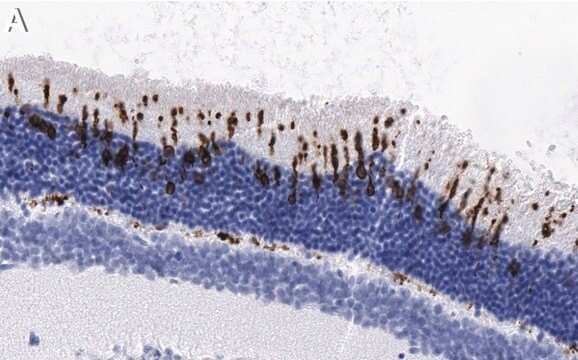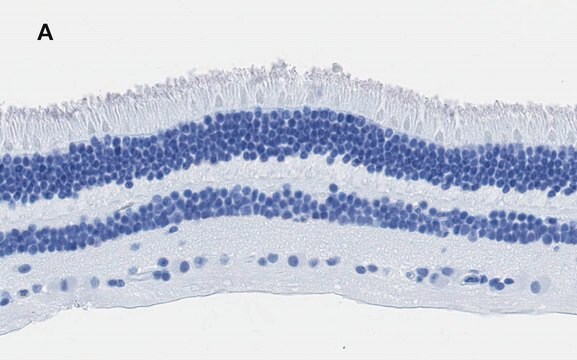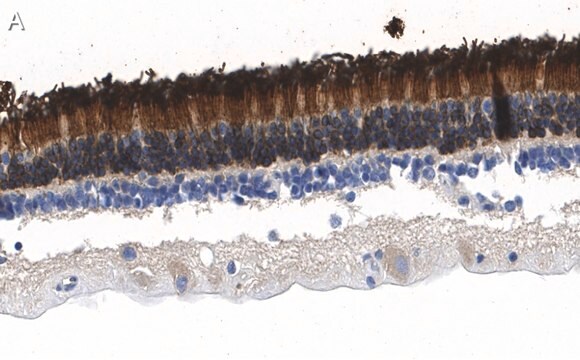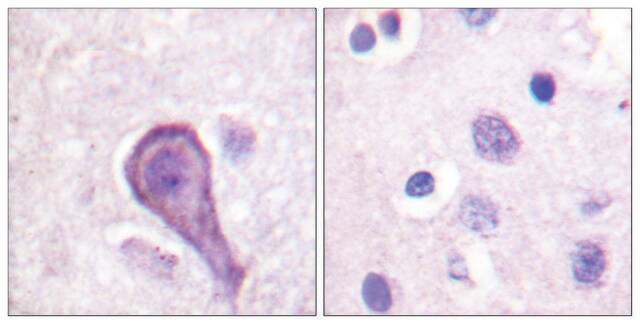MABN15
Anti-Rhodopsin Antibody, clone 4D2
clone 4D2, from mouse
Synonim(y):
rhodopsin, rhodopsin (opsin 2, rod pigment) (retinitis pigmentosa 4, autosomal dominant), retinitis pigmentosa 4, autosomal dominant, opsin 2, rod pigment
About This Item
Polecane produkty
pochodzenie biologiczne
mouse
Poziom jakości
forma przeciwciała
purified immunoglobulin
rodzaj przeciwciała
primary antibodies
klon
4D2, monoclonal
reaktywność gatunkowa
rat, human, fish
reaktywność gatunkowa (przewidywana na podstawie homologii)
mouse (based on 100% sequence homology)
metody
ELISA: suitable
immunocytochemistry: suitable
immunohistochemistry: suitable
western blot: suitable
izotyp
IgG2bκ
numer dostępu NCBI
numer dostępu UniProt
Warunki transportu
wet ice
docelowa modyfikacja potranslacyjna
unmodified
informacje o genach
human ... RHO(6010)
rat ... Rho(24717)
Opis ogólny
Specyficzność
Immunogen
Zastosowanie
Neuroscience
Sensory & PNS
Immunocytochemistry: A previous lot of this antibody detected Rhodopsin by ICC in goldfish retina tissue, as reported by Knight K, et al
Immunohistochemistry Analysis: 1:500 dilution of this antibody has been shown to detect Rhodopsin in human eye tissue.
ELISA: Specificity of this antibody, from a different lot, was validated in a competitive ELISA, as reported by Laird D, et al.
Jakość
Immunohistochemistry Analysis: 1:500 dilution of this antibody detected Rhodopsin in rat eye tissue.
Opis wartości docelowych
Postać fizyczna
Przechowywanie i stabilność
Komentarz do analizy
Rat eye tissue
Inne uwagi
Oświadczenie o zrzeczeniu się odpowiedzialności
Nie możesz znaleźć właściwego produktu?
Wypróbuj nasz Narzędzie selektora produktów.
polecane
Kod klasy składowania
12 - Non Combustible Liquids
Klasa zagrożenia wodnego (WGK)
WGK 1
Temperatura zapłonu (°F)
Not applicable
Temperatura zapłonu (°C)
Not applicable
Certyfikaty analizy (CoA)
Poszukaj Certyfikaty analizy (CoA), wpisując numer partii/serii produktów. Numery serii i partii można znaleźć na etykiecie produktu po słowach „seria” lub „partia”.
Masz już ten produkt?
Dokumenty związane z niedawno zakupionymi produktami zostały zamieszczone w Bibliotece dokumentów.
Nasz zespół naukowców ma doświadczenie we wszystkich obszarach badań, w tym w naukach przyrodniczych, materiałoznawstwie, syntezie chemicznej, chromatografii, analityce i wielu innych dziedzinach.
Skontaktuj się z zespołem ds. pomocy technicznej








